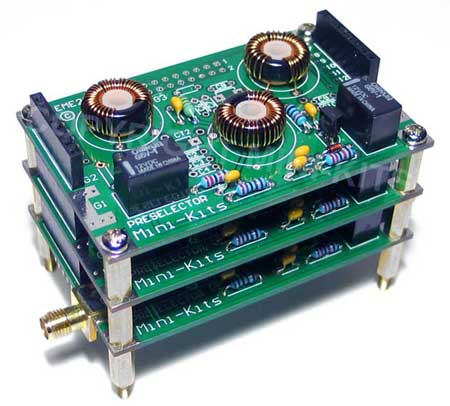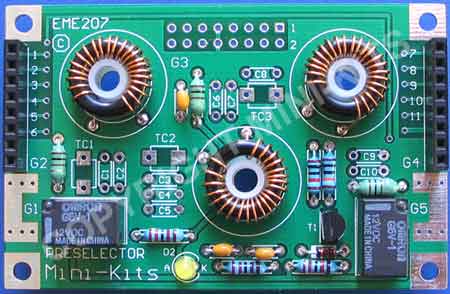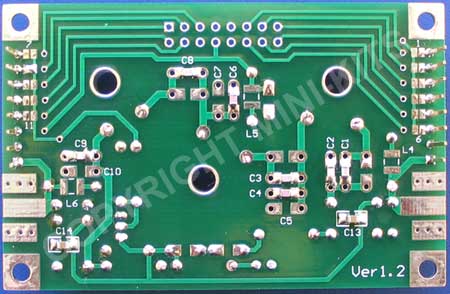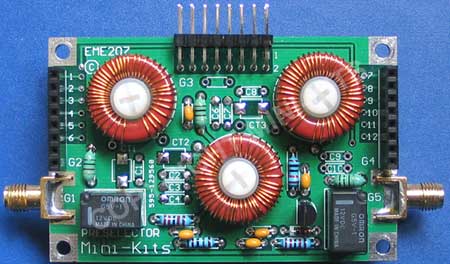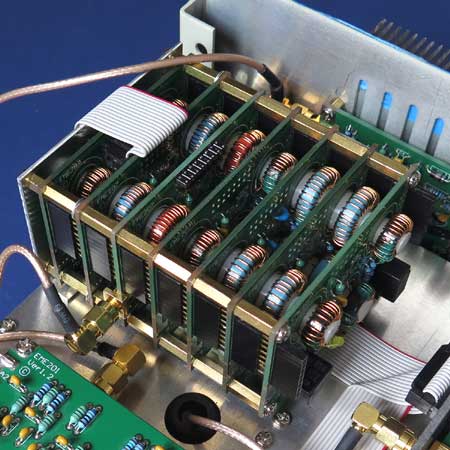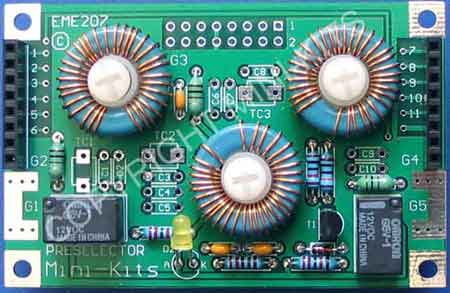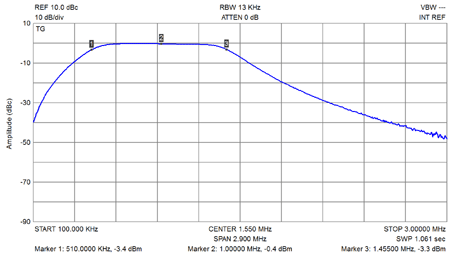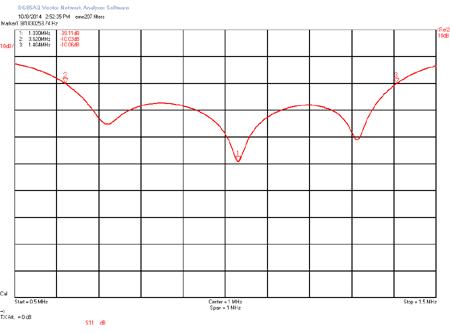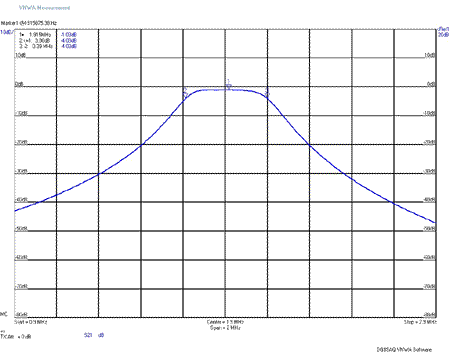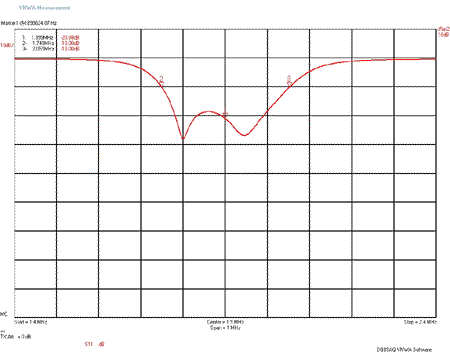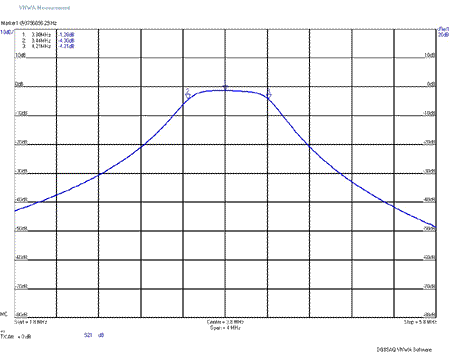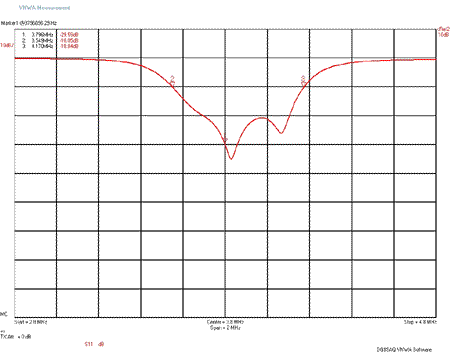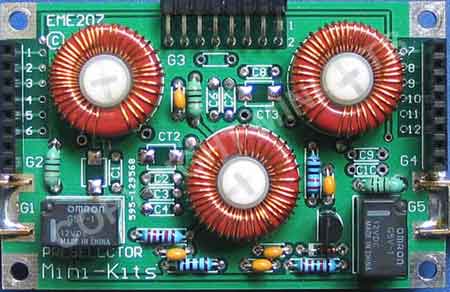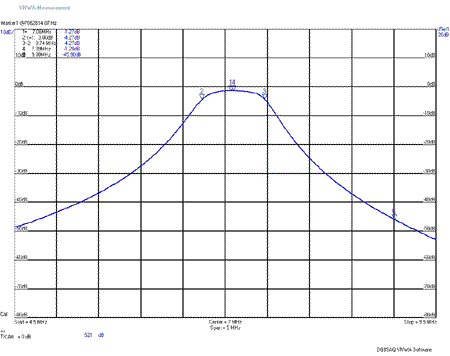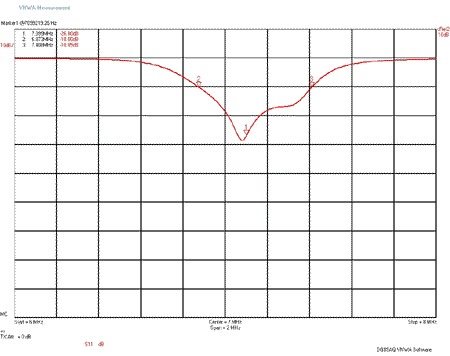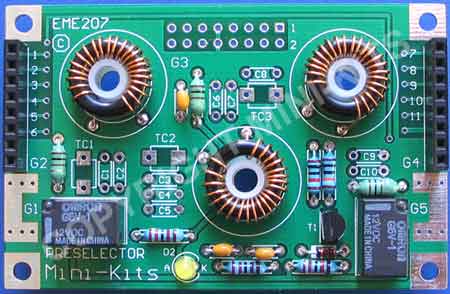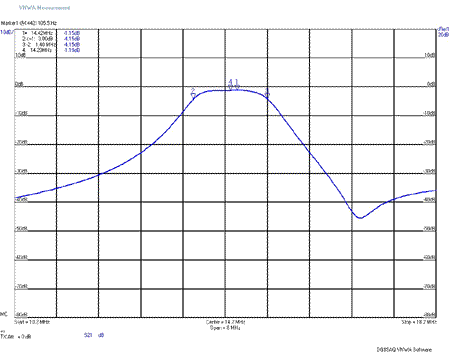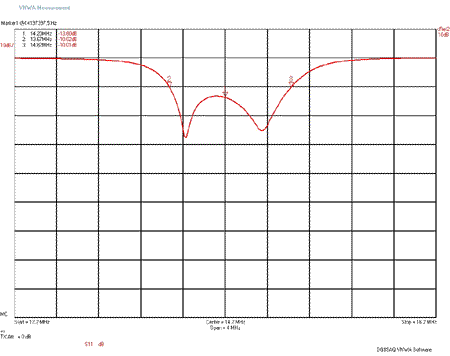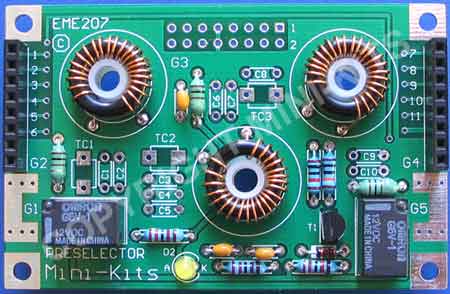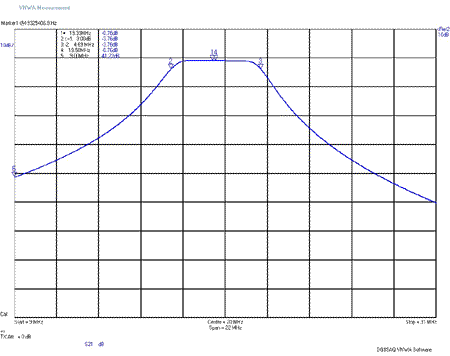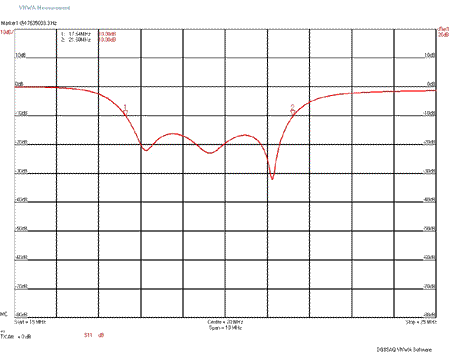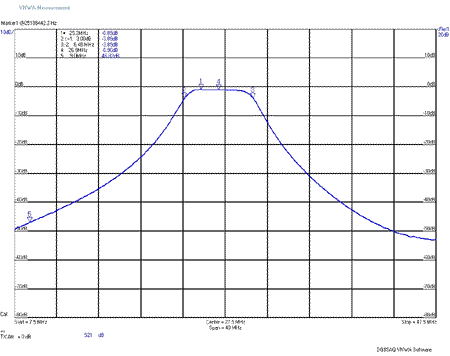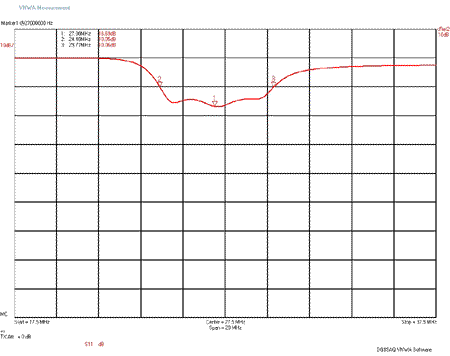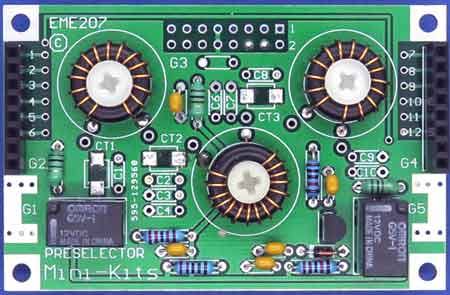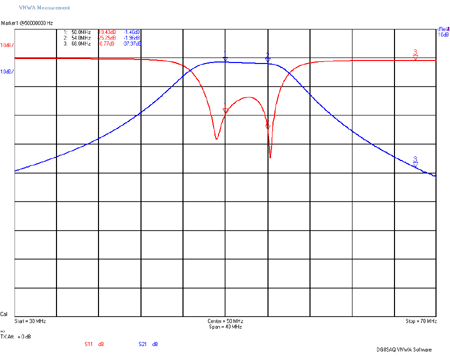EME207 HF Pre-selector Filter Kits
- EME207 Module Description:
Updated! June 2022
- EME207 Kit Constructors Alert:
Updated! Dec 2016 - EME207 Kit Construction Notes:
- EME207-BC Kit: MW Broadcast band 7th order band pass filter
- EME207-160M Kit: 160 metre band 7th order band pass filter
- EME207-80M Kit: 80 metre band 7th order band pass filter
- EME207-40M Kit: 40 metre band 7th order band pass filter
- EME207-20M Kit: 20 metre band 7th order band pass filter
- EME207-17-15M Kit: 17 to 15 metre band 7th order band pass filter
- EME207-12-10M Kit: 12 to 10 metre band 7th order band pass filter
- EME207-6M Kit: 6 metre band 7th order band pass filter
- Kit changes and Updates:
Updated! Apr 2015 - M1 Transceiver Block
Diagram Rev1.5:
Updated! Apr 2017 - M1 Series Transceiver Web page:
- Buy a EME207 Series Filter Kit:
The Mini-Kits EME207 Pre-selector Filter modules are part of the M1 series building blocks to construct a high performance M1 HF Transceiver. The Mini-Kits EME207 PC Board has been designed for constructing simple filters using either conventional leaded, or SMD components. Kit part numbers are prefixed for filter type, ( LPF Low Pass, BPF Band Pass or HPF High Pass ), the number after is the number of poles, followed by the band or frequency in MHz. These filters are easy to construct, and require minimal alignment if constructed as per the Kit notes.
The filters are used as band pass filters in the receiver front
end, and also in the low level transmit driver stages, and cover the
160M to 6M Ham bands, ( excluding 30M ).
The 6M band is a compromise as a 5 to 6 pole filter is really required for image rejection, but the EME207 board can only fit up to 3 poles. The filter design was modified in Elsie to cover the 50 to 54MHz bands with less than 1.5dB loss and provides a marginal 36dB of rejection at 50MHz + 2x 9MHz IF = 68MHz. There are probably no issues as the VHF low band is not used in many countries, but I will look at the possibility of adding a 68MHz trap filter and doing some tests as a future update.
Due to the lower frequency roll off of mesh capacitor coupled filters, the 9MHz IF rejection especially with the 20M, 17/15M, and 12/10M band filters is compromised, so a 9MHz IF trap filter is recommended to improve the IF rejection to avoid overloading or causing interference to the IF amplifier. The EME211 Kit can be used which can be used to provide >50dB of extra rejection at 9MHz.
Filter modules can be stacked to cover all the bands ( excluding 30M ) from 160M to the 6M bands, and are selectable via a single 16 Pin IDC header that uses +ve logic to select the filter for the selected band. Links and diodes on the bottom of the board are fitted to allow easy configuration of the filter module to the required band logic. When the logic control to the filter is turned off, the relays isolate the filter from the RF signal path by grounding it, and a wetting current is used to help prolong the life of the relay contacts.
The M1 HF Series Kits have been designed to allow easy construction due to the use of mainly leaded components for those that don't like surface mount devices. SMD components are only used when required due to availability of components, or for better performance. The RF modules are all designed with a 50ohm impedance making it easy to interconnect with the other M1 series modules, and your own home brew circuit designs.
1/ Some 40M band Kits around November December 2016 may have been supplied with a J310 FET instead of a 2N7000 FET. This will not work as the pinout is different and so the relays will not activate. Please contact us so that we can post the correct 2N7000 to you.
2/ L4 and L6 RF chokes are only required on the first filter module, as a return DC path to ground for the relay wetting current. Adding additional filters may cause problems with the inductance from the RF to ground connections being reduced, when filter modules are stacked. Tests looking at the 6M band filter showed that stacking boards does increase the filter loss and decreases the return loss. So it is recommended to remove or cut the inductors from additional boards.
The images below show both sides of the board. The module uses a number of tiny SMD capacitor that could not be avoided as it makes the module more compact and offers better performance. The inductors for each filter need to be wound with the correct number of turns as per the Kit construction notes to work correctly. Filter boards should be stacked so that adjacent harmonically related bands are not next to each other. This reduces the coupling of the toroids between filters that could affect the filters response. It is suggested that the 40M band module be used as the first filter module that has SMA connectors fitted. The order of stacking the filters can affect mainly the higher frequency bands, so some experimentation may be needed to see the lowest loss on these bands. There was nothing to indicate that the headers increased the loss on the 6M band when it was stacked up to 5 modules from the first filter module. A suggested stacking order that works is 80M, 20M, 160M, 40M, 17/15M, BC, 10/12M, 6M.
1/ The module that is used in the middle of the stacked modules is
called the first filter module and has SMA connectors and a right
angle 16 way header connector for the logic control fitted.
2/ M3x12mm nylon or metal spacers are used to stack the module boards. There has been no measured difference with RF losses or impedance mismatch if nylon spacer are used to save cost.
3/ Some of the low frequency filter modules use the larger T68 size toroids, and have some issues with the length of the nylon countersunk 4mm screws being a bit short to easily tighten up the nylon nuts. Longer 15mm screws did not work as the diameter of the countersunk head was larger than the 12mm screws, and did not allow the filter modules to plug together correctly with the 12mm long spacers.
4/ L4 and L6 RF chokes are only required on the first filter module, as a return DC path to ground for the relay wetting current. Adding additional filters may cause problems with the inductance from the RF to ground connections being reduced, when filter modules are stacked. Tests looking at the 6M band filter showed that stacking boards does increase the filter loss, and decreases the return loss. So it is recommended to remove or cut the inductors from additional boards.
Designed as a front end filter for the 550 to 1600MHz Medium Wave Broadcast band. Designed for steep roll off under 500kHz to reduce low frequency man made noise, and provides over 90dB IF rejection at 9MHz. Filters have been modelled on the PA3AKE Chebyshev filter designs, and cover the popular HF amateur bands. Low loss NPO ceramic capacitors have been used along with wire wound high Q inductors to reduce RF losses.
There is some issues when using the BCB on the M1 transceiver due I think to the local oscillator being very close to the IF frequency. When receiving on AM mode, there is some breakthrough of AM through to the IF when tuned off stations even when using high attenuation on the receiver input. I have not quite worked of why this happens so if you know the answer please let me know.
Designed as a front end filter for the 160 metre band. Provides over 90dB IF rejection at 9MHz. Filters have been modelled on the PA3AKE Chebyshev filter designs, and cover the popular HF amateur bands. Low loss NPO ceramic capacitors have been used along with wire wound high Q inductors to reduce RF losses.
Designed as a front end filter for the 80 metre band. Provides over 80dB IF rejection at 9MHz. Filters have been modelled on the PA3AKE Chebyshev filter designs, and cover the popular HF amateur bands. Low loss NPO ceramic capacitors have been used along with wire wound high Q inductors to reduce RF losses.
The 40M Band Pre-selector filter is modelled on the PA3AKE 7th order Chebyshev design and uses low loss NPO ceramic capacitors, along with wire wound high Q Toroidal inductors to reduce RF losses. The centre frequency of the filter has been tuned to 7.15MHz, and has a 3dB bandwidth of around 760kHz that allows the full coverage of the 40M band. The IF rejection at 9MHz is around 46dB, so a suitable 9MHz trap filter is recommended when using a 9MHz IF to improve the rejection.
Designed as a front end filter for the 20 metre band. Filters have been modelled on the PA3AKE Chebyshev filter designs, and cover the popular HF amateur bands. Low loss NPO ceramic capacitors have been used along with wire wound high Q inductors to reduce RF losses. The IF rejection at 9MHz is only around 40dB, so a suitable 9MHz trap filter is required to improve the rejection.
Designed as a front end filter for the 17 and 15M Band ( 18 to 22MHz ). The filter is modelled on the PA3AKE 7th order Chebyshev design and uses low loss NPO ceramic capacitors, along with wire wound high Q Toroidal inductors to reduce RF losses. The centre frequency of the filter has been tuned to 19.5MHz, and has a 3dB bandwidth of around 4.7MHz that allows the full coverage of the 15 and 17M bands. The IF rejection at 9MHz is only around 40dB, so a suitable 9MHz trap filter is required to improve the rejection
Designed as a front end filter for the 12 and 10 metre Band, ( 24 to 30MHz ). Provides over 45dB IF rejection at 9MHz. Filters have been modelled on the PA3AKE Chebyshev filter designs, and cover the popular HF amateur bands. Low loss NPO ceramic capacitors have been used along with wire wound high Q inductors to reduce RF losses.
The 6M band filter is a compromise as a 5 to 6 pole filter is really required for image rejection, but the EME207 board can only fit up to 3 poles. The filter design was modified in Elsie to cover the 50 to 54MHz bands with less than 1.5dB loss and provides a marginal 36dB of rejection at 50MHz + 2x 9MHz IF = 68MHz. There are probably no issues as the VHF low band is not used in many countries, but I will look at the possibility of adding a 68MHz trap filter and doing some tests as a future update.
1/ L4 and L6 RF chokes are only required on the first filter module, as a return DC path to ground for the relay wetting current. Adding additional filters may cause problems with the inductance from the RF to ground connections being reduced, when filter modules are stacked. Tests looking at the 6M band filter showed that stacking boards does increase the filter loss and decreases the return loss. So it is recommended to remove or cut the inductors from additional boards.
2/ The 15M band filter Kit has been discontinued as there was no need to have separate filters for the 12, and 17M Warc bands. The Warc bands have now been combined to a 12/10M and 17/15M band filters.
3/ Early BC Band filter Kits have 2x C4/C6 being incorrectly supplied as 2x 33nF capacitors, but these should be 2x 3.9nF. Also C3 is not shown in the parts list or on the board overlay diagram and is a 33nF. The original schematic diagram is however correct and shows the correct capacitor values and numbers. Please contact Mini-Kits so that we can supply you with the correct parts and documentation.

